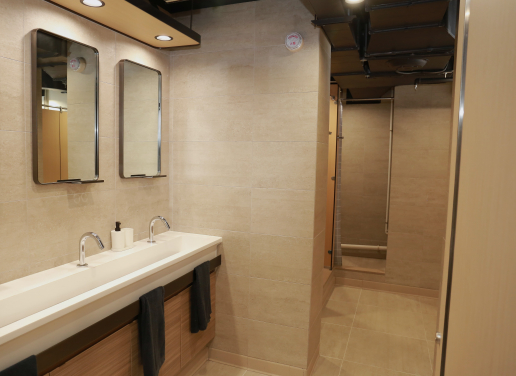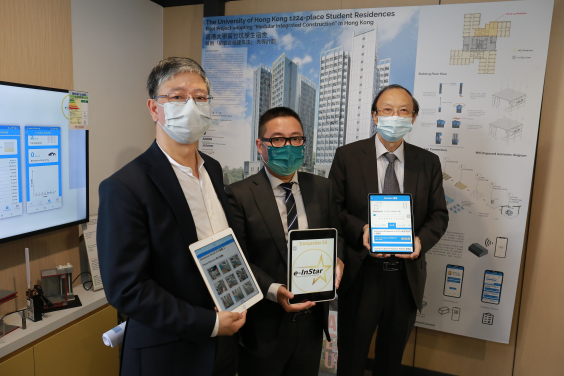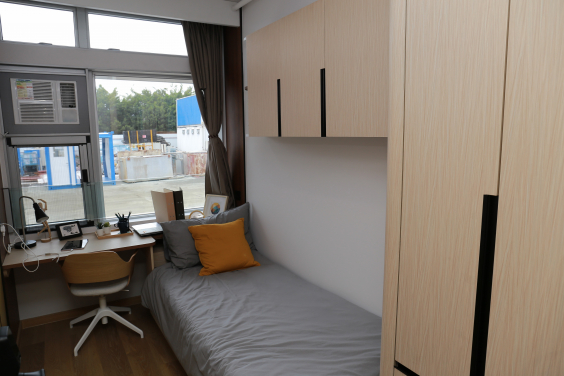Media
HKU Architecture Research Team Develops Blockchain-enabled E-Inspection 2.0 for Effective Offsite Monitoring of Student Residence Using Modular Integrated Construction
06 Jun 2022

(from left) Ir Mr. KL Tam, Director of Estates; Professor Wilson Lu, Department of Real Estate and Construction; and Professor Anthony Yeh, Department of Urban Planning and Design, Faculty of Architecture, HKU

key components of the e-inspection 2.0 system: (left), device for real-time proof of location using the smart address technology, (middle) e-inStar App and (below) "birth certificate" of a module, (right) i-Core for real-time collection of temperature, humidity, vibration, and location information during transportation
- 1 / 5
- 2 / 5
- 3 / 5
- 4 / 5
- 5 / 5
A team from the Faculty of Architecture of the University of Hong Kong (HKU) has developed a novel e-inspection 2.0 system with an in-house developed mobile application (APP) “e-inStar”, which is used to monitor the manufacturing and cross-border delivery of student residence modules constructed in the Mainland during the COVID-19 pandemic.
The new system has adopted cutting-edge digital technologies including blockchain, building information modelling (BIM), internet of things (IoTs), and geographical information system (GIS), and is demonstrated to be an effective and reliable tool for real-time offshore monitoring and inspection of building works.
“This e-inspection 2.0 system is a world’s first. It has set new standards and will serve as a prototype for the industry,” said Professor Wilson Lu of the Department of Real Estate and Construction, who led the study. Other members included Dr. Frank Xue from the same Department, Professor Anthony Yeh from the Department of Urban Planning and Design, and Ir Mr. KL Tam, Director of Estates.
The research findings have been published in the Journal of Management in Engineering, an academic journal of the American Society of Civil Engineers (ASCE).
Modular Integrated Construction (MiC) was first mentioned in the HKSAR Chief Executive’s 2017 Policy Address as a solution to address the pressing housing problem in the territory by expediting the building process to increase supplies. By shifting a significant portion of traditional on-site works to modules mass produced and integrated in factories, the new method has the advantages of substantially shortening construction time, addressing the problem of manpower shortage in Hong Kong and reducing the environmental impacts brought by construction works.
The HKU Wong Chuk Hang Student Residence is a pilot project built with the MiC technology. The two 17-floor tower buildings on top of a three-story podium structure will provide 1,224 student hall places. The project is scheduled to be completed by the second quarter of 2023. The building work involves a total of approximately 1,000 modular units (e.g., rooms and toilets), which will be manufactured offsite in a factory located in Guangdong Province. Inspected and qualified modular units are then transported to Hong Kong using containers via ships and trucks, and assembled at the construction site in Wong Chuk Hang.
Before the COVID-19 pandemic, qualified inspectors were dispatched across the border to perform inspection works to ensure that modules manufactured in the Mainland and delivered to Hong Kong for on-site installation meet the required quality standards. This involved a lot of manpower and onerous paperwork.
The current e-inspection 1.0 system used by the industry adopts some digital means, which allow easing of some paperwork, such as uploading of inspection photos and documents for filing and records, but inspectors’ physical presence onsite remains necessary.
During the COVID-19 pandemic, infectious control measures such as social distancing and border control measures have made sending authorised persons from Hong Kong to Mainland factories for onsite inspections extremely difficult.
The new e-inspection 2.0 system consists of a mobile application called e-inStar which encodes the standardised inspection processes of MiC and enables inspection works in an offshore factory. The detailed operations are as follows:
- The contractor generates a list of inspection tasks for a specific project.
- Different stakeholders (e.g., registered structure engineer, authorised person) register on the platform and state their role types.
- A two-factor authentication (2FA) (i.e., password and fingerprint) will confirm the identity of the inspectors.
- When a construction task is completed, the contractor checks the target objects regarding the check items and records the corresponding data (i.e., inspection results and photos)
- At hold points, the client representative and/or registered structural engineer, authorised person, and building service inspector ask the contractor’s inspectors to recheck target objects under their real-time video supervision.
- The recheck results are compared with the record, and if they are the same and in compliance, the client representative and/or registered structural engineer, authorised person, and building service inspector can digitally sign the record in the distributed blockchain network.
- If any inconsistency or noncompliance is spotted, a request for re-inspection will be sent to the contractor. All records on procedures, being dispersed and stored in the blockchain network, are totally traceable.
- The signed record is converted into a legally effective document and stored in a distributed blockchain network. All records are thus immutable and safeguarded in the blockchain network.
Also, IoTs are utilised to collect temperature, humidity, vibration, and location information; GIS supports real-time proof of location, while BIM is used for better information management and presentation.
“The core of the e-inspection 2.0 system is the blockchain technology which can ensure the accountability, immutability, and traceability of all the inspection information collected from the APP, IoTs, and GIS,” said Professor Lu.
Professor Lu's iLab team has been engaged in the development and research of BIM and blockchain, effectively integrating and managing all kinds of information such as design, construction, operation for high-end technology applications. The “i-core” technology developed by Professor Lu’s team won the Construction Industry Council (CIC) Young Innovator Award 2015.
"GPS technology can provide certificate of origin and real-time proof of location (PoL). Managers can view the real-time location of the module at any time, with accurate spatiotemporal data for real-time management of materials in construction projects, thereby improving work efficiency," said Professor Anthony Yeh, an GIS expert. His team has carried out pioneer research and development of indoor and outdoor navigation systems, and has generated many patents. The application programme and smart address system developed by Professor Yeh’s team has been applied in this project for logistics monitoring.
"The high-end technology used by experts from the Faculty of Architecture, combined with our practical experience in engineering, resulted in the new e-inspection system and the e-inStar platform, which has proven to be reliable and effective, enabling us to monitor all details of the module manufacturing process, and the entire transportation process after the modules leave the factory. We can instantly know the location, temperature, or whether the modules are damaged due to moisture or vibration etc. Each module will have its own "birth certificate", which clearly records the details of each testing process and the persons responsible etc.," said Mr. KL Tam, Director of Estates. He hoped that the new system can be widely adopted to further drive innovation in the local construction industry.
The project was supported by the Logistics and Supply Chain MultiTech R&D Centre established under the Innovation and Technology Fund.
For a demonstration video of the e-inStar App, please click here.
For the powerpoint slides presented at the media conference, please click here.
For the article published in the Journal of Management in Engineering, please click here.
Media enquiries:
Communications and Public Affairs Office, HKU
Ms Melanie Wan (Email: melwkwan@hku.hk)
Ms Rashida Suffiad (Email: rsuffiad@hku.hk)



